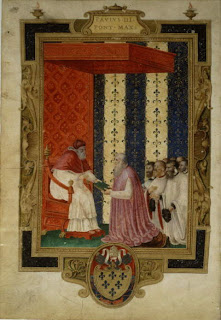An early engraving of the Sistine Chapel shows the full pomp of a papal religious ceremony, with the pope, the entire papal curia, and the singers in their box (lower right) gathered around a lectern. Every important participant is identified by a number corresponding to a legend at the bottom of the page. The pope on his throne at the left is no. 4, and the papal singers in their "cantoria" are no. 51.
The earliest complete extant constitution outlines the singers' duties, privileges, and code of behavior and offers detailed rules for their daily personal and professional life. The beautiful illuminated full-page opening miniature portrays the reigning pope Paul III presenting the constitution to the master of the papal chapel, with the singers of the chapel kneeling behind him.
Stefano Landi (ca. 1586-1639) was a member of the papal chapel in Rome and also worked for the powerful Barberini family. In 1632 his opera "Sant'Alessio," with a libretto by Giulio Rospigliosi (1600-69), later Pope Clement IX, was premiered in the Barberini palace in Rome; the score was published two years later. Although most early operas drew their plots from pagan mythology, this work is based on Christian hagiography--the life of the fifth-century Saint Alexis--yet also contains comic characters and elaborate scenic effects. The woodcut illustration displayed here shows one of those scenes, depicting nothing less than Hell itself.
Treatises on Music [image this time cant find it SORRY!!] >.<
In Greek
Mid-sixteenth century
This collection of the most important ancient Greek treatises on music, includes works by Aristoxenus, Ptolemy, Plutarch, Cleonides, and many others. It has been elegantly copied in the original language and was owned by Cardinal Marcello Cervini, whose coat of arms can be seen at the bottom of the page on display--the beginning of a treatise by Aristoxenus. In 1555 Cervini was elected pope as Marcellus II, and his name was attatched to the title of Palestrina's famous "Missa Papae Marcelli."
Early sixteenth centuryThe composer Carpentras was master of the papal chapel during the reign of Pope Leo X and wrote, among other things, polyphonic settings of the Lamentations of Jeremiah--part of the liturgy of Holy Week. Returning to Rome for a visit after Leo's death, he heard performances or saw copies of his Lamentations that were so different from what he had originally composed that he decided to present the reigning pope Clement VII (1522-1534) with a decorated parchment manuscript, on display here, containing the "correct" and "authentic" version of his music.
The constitution of the papal singers required that individual singers be fined varying amounts if they came late or missed any of the daily services. Beginning in 1535 these fines were recorded in books known as the Diarii Sistini. Occasionally these documents tell us other things, such as in the entry on this folio (translated below). Many people in the late sixteenth century were very concerned that the congregation could not understand the sacred words of a Mass sung in polyphony. Here the papal singers try out some Masses--unfortunately not named--that addressed this problem:
At the request of the Most Reverend Cardinal Vitellossi we were assembled in his residence to sing some Masses and to test whether the words could be understood, as their Eminences desire; and those who were absent were fined:
Federicus baiocchi 15
Petrus baiocchi 15
Petrus Paulus baiocchi 15
Mathias baiocchi 15
Soto baiocchi 15
i will stop here fro now~ i will post with pictures i really hope it will b more interesting so please read it.






No comments:
Post a Comment